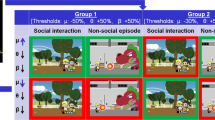Abstract
Reduced seizure incidence coupled with voluntary motor inhibition accompanied conditioned increases in the sensorimotor rhythm(SMR), a 12–14 Hz rhythm appearing over rolandic cortex. Although SMR biofeedback training has been successfully applied to various forms of epilepsy in humans, its potential use in decreasing hyperactivity has been limited to a few cases in which a seizure history was also a significant feature. The present study represents a first attempt to explore the technique's applicability to the problem of hyperkinesis independent of the epilepsy issue. The results of several months of EEG biofeedback training in a hyperkinetic child tend to corroborate and extend previous findings. Feedback presentations for SMR were contingent on the production of 12–14-Hz activity in the absence of 4–7-Hz slow-wave activity. A substantial increase in SMR occurred with progressive SMR training and was associated with enhanced motor inhibition, as gauged by laboratory measures of muscular tone(chin EMG) and by a global behavioral assessment in the classroom. Opposite trends in motor inhibition occurred when the training procedure was reversed and feedback presentations were contingent on the production of 4–7 Hz in the absence of 12–14-Hz activity. Although the preliminary nature of these results is stressed, the subject population has recently been increased to establish the validity and generality of the findings and will include the use of SMR biofeedback training after medication has been withdrawn.
Similar content being viewed by others

References
Chase, M. H., & Harper, R. M. Somatamotor and visceromotor correlates of operantly conditioned 12–14 C/sec sensorimotor cortical activity.Electroencephalography and Clinical Neurophysiology 1971,31 85–92.
Donhoffer, H., & Lissak, K. EEG changes associated with the elaboration of conditioned reflexes.Acta Physiologica Academy of Science, Hungary 1962,21 249–255.
Finley, W. W., Smith, H. A., & Etherton, M. D. “Reduction of seizures and normalization of the EEG in a severe epileptic following sensorimotor biofeedback training: Preliminary study.Biological Psychology 1975,2 195–209.
Howe, R. C., & Sterman, M. B. “Cortical-subcortical EEG correlates of suppressed motor behavior during sleep and waking in the cat.Electroencephalography and Clinical Neurophysiology 1972,32 681–695.
Lubar, J. F., & Bahler, W. W. Behavioral management of epileptic seizures following EEG biofeedback training of the sensorimotor rhythm.Biofeedback and Self-Regulation 1976,1 47–61.
Millichap, J. G. Drugs in the management of hyperactive children.Journal of American Medical Association 1968,206 1527–1530.
Roth, S. R., Sterman, M. B., & Clemente, C. D. Comparison of EEG correlates of reinforcement, internal inhibition and sleep.Electroencephalography and Clinical Neurophysiology 1967,23 509–520.
Seifert, A. R., & Lubar, J. F. Reduction of epileptic seizures through EEG Biofeedback Training.Biological Psychology 1975,3 157–184.
Shouse, M. N., & Lubar, J. F. Management of the hyperkinetic syndrome in children concurrent with sensorimotor rhythm (SMR) biofeedback training.Proceedings of the Biofeedback Research Society Colorado Springs, Colorado, 1976.
Sterman, M. B., & Friar, L. Suppression of seizures in an epileptic following sensorimotor EEG feedback training.Electroencephalography and Clinical Neurophysiology 1972,33 89–95.
Sterman, M. B., LoPresti, R. W., & Fairchild, M. D. Electroencephalographic and behavioral studies of monomethylhydrazine toxicity in the cat.Technical Report AMRL-TR-69-3, Aerospace Medical Research Laboratories, Aerospace Medical Division Air Force Systems Command, Wright-Patterson Air Force Base, Ohio, 1969.
Sterman, M. B., Macdonald, L. R., & Stone, R. K. Biofeedback training of the sensorimotor electroencephalographic rhythm in man: Effects on epilepsy.Epilepsia 1974,15 395–416.
Sterman, M. B., & Wyrwicka, W. EEG correlates of sleep: Evidence for separate forebrain substrates.Brain Research 1967,6 143–163.
Stewart, M. A., Pitts, F. N., Craig, A. G., & Dierak, W. The hyperactive child syndrome.American Journal of Orthopsychiatry 1966,36 861–867.
Wahler, R. G. Some structural aspects of deviant child behavior.Journal of Applied Behavior Analysis 1975,8 27–42.
Wahler, R. G., House, A. E., & Starbaugh, E. E.Ecological assessment of child problem behavior. Pergamon Press. In press, 1975.
Author information
Authors and Affiliations
Additional information
This research was a segment of the junior author's dissertation research.
Rights and permissions
About this article
Cite this article
Lubar, J.F., Shouse, M.N. EEG and behavioral changes in a hyperkinetic child concurrent with training of the sensorimotor rhythm (SMR). Biofeedback and Self-Regulation 1, 293–306 (1976). https://doi.org/10.1007/BF01001170
Received:
Issue Date:
DOI: https://doi.org/10.1007/BF01001170



